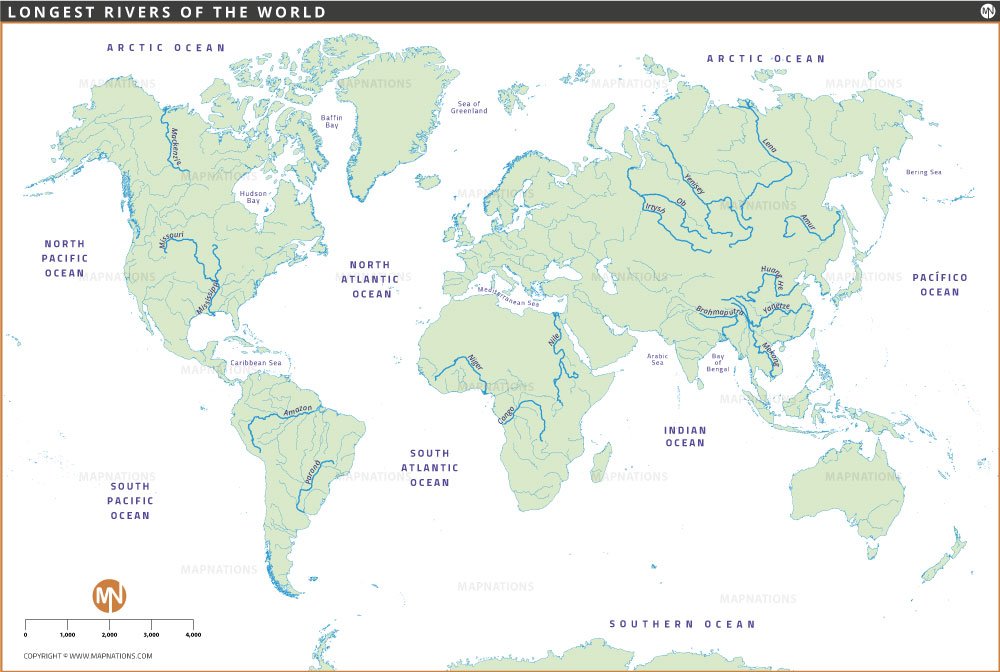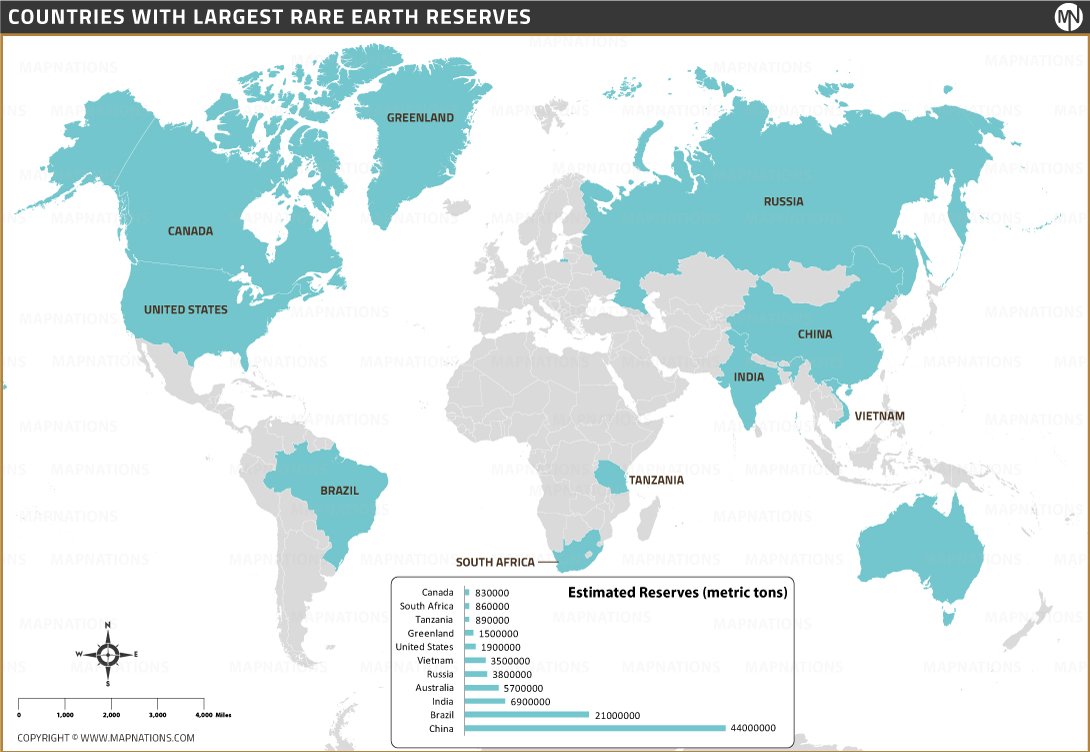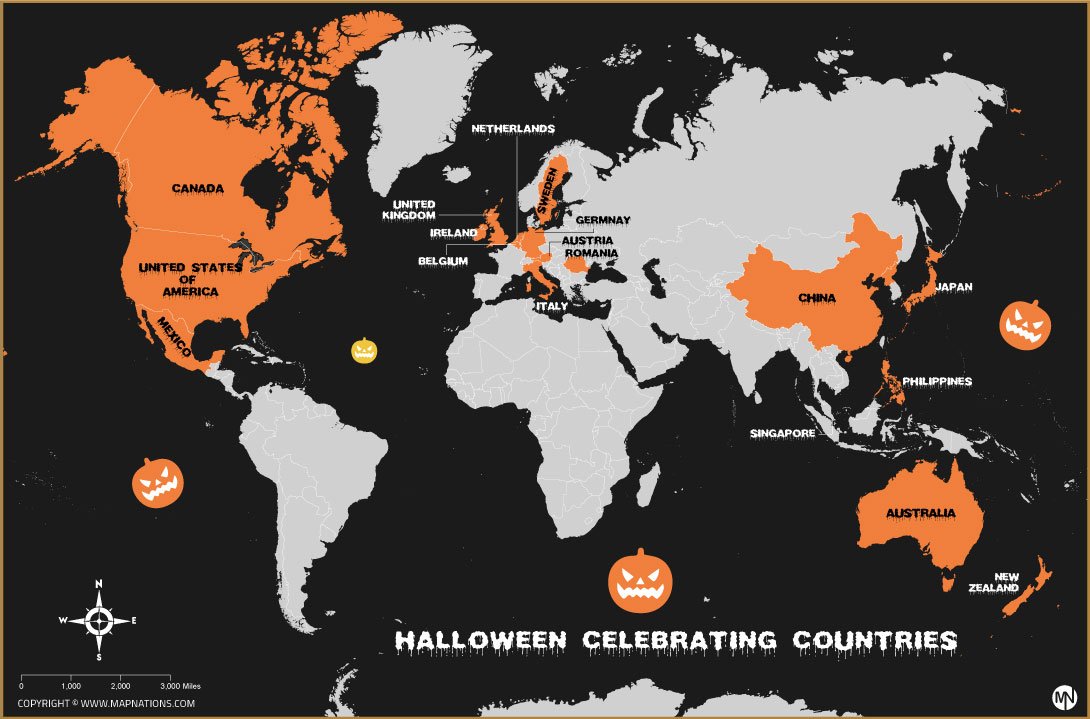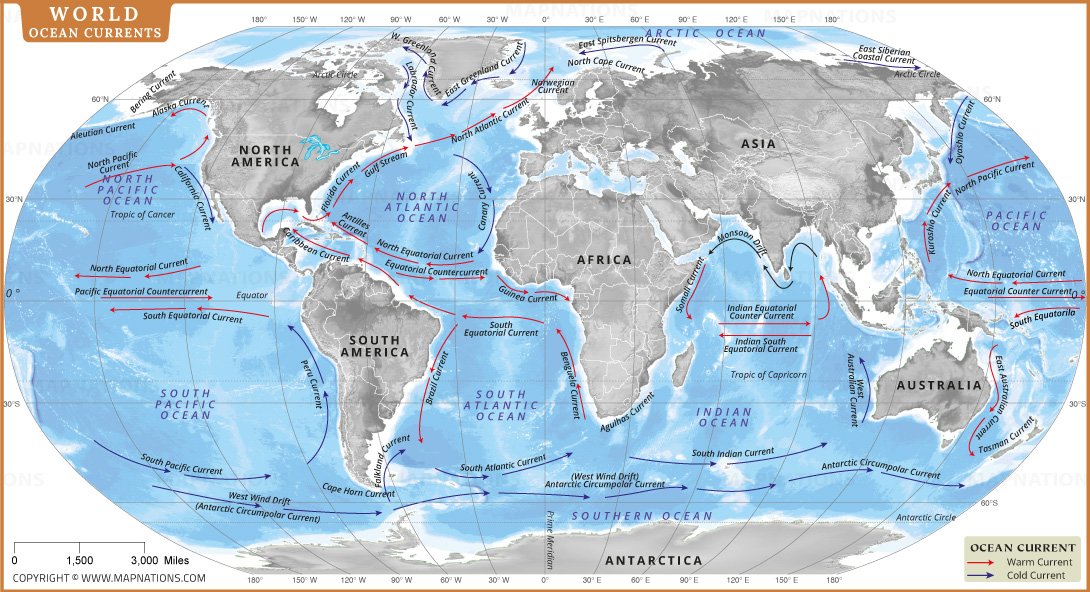World's Longest Rivers
This map highlights the longest rivers in the world, showcasing their courses across continents and their geographical significance. Major rivers such as the Amazon, Nile, Mississippi, Yangtze, and Yenisei are prominently featured, illustrating their vast networks and influence on civilizations, ecosystems, and economies. Each river plays a crucial role in water supply, agriculture, transportation, and biodiversity.

| No. | River Names | Length (km) | Outflow | Countries Sharing Drainage Basin |
|---|---|---|---|---|
| 1 | Nile | 7,088 | Mediterranean | Ethiopia, Eritrea, Sudan, Uganda, Tanzania, Kenya, Rwanda, Burundi, Egypt, the Democratic Republic of the Congo, South Sudan |
| 2 | Amazon | 6,575 | Atlantic Ocean | Brazil, Peru, Bolivia, Colombia, Ecuador, Venezuela, Guyana |
| 3 | Yangtze | 6,418 | East China Sea | China |
| 4 | Mississippi | 6,275 | Gulf of Mexico | United States (98.5%), Canada (1.5%) |
| 5 | Yenisei | 5,539 | Kara Sea | Russia (97%), Mongolia (2.9%) |
| 6 | Yellow River | 5,464 | Bohai Sea | China |
| 7 | Ob-Irtysh | 5,410 | Gulf of Ob | Russia, Kazakhstan, China, Mongolia |
| 8 | Río de la Plat | 4,880 | Río de la Plata | Brazil (46.7%), Argentina (27.7%), Paraguay (13.5%), Bolivia (8.3%), Uruguay (3.8%) |
| 9 | Congo | 4,700 | Atlantic Ocean | Democratic Republic of the Congo, Central African Republic, Angola, Republic of the Congo, Tanzania, Cameroon, Zambia, Burundi, Rwanda |
| 10 | Amur | 4,444 | Sea of Okhotsk | Russia, China, Mongolia |
| 11 | Lena | 4,400 | Laptev Sea | Russia |
| 12 | Mekong | 4,350 | South China Sea | China, Myanmar, Laos, Thailand, Cambodia, Vietnam |
| 13 | Mackenzie | 4,241 | Beaufort Sea | Canada |
| 14 | Niger | 4,200 | Gulf of Guinea | Nigeria (26.6%), Mali (25.6%), Niger (23.6%), Algeria (7.6%), Guinea (4.5%), Cameroon (4.2%), Burkina Faso (3.9%), Côte d'Ivoire, Benin, Chad |
| 15 | Brahmaputra | 3,969 | Ganges | India (58.0%), China (19.7%), Nepal (9.0%), Bangladesh (6.6%), Disputed India/China (4.2%), Bhutan (2.4%) |
This map highlights the longest rivers in the world, showcasing their courses across continents and their geographical significance. Major rivers such as the Amazon, Nile, Mississippi, Yangtze, and Yenisei are prominently featured, illustrating their vast networks and influence on civilizations, ecosystems, and economies. Each river plays a crucial role in water supply, agriculture, transportation, and biodiversity.
Rivers shape landscapes, create fertile plains, and support millions of people. Understanding their paths and importance fosters appreciation for freshwater ecosystems and conservation. This map is an essential resource for geographers, students, and nature enthusiasts exploring the world’s great rivers.
- Afghanistan
- Albania
- Algeria
- Andorra
- Angola
- Antigua and Barbuda
- Argentina
- Armenia
- Australia
- Austria
- Azerbaijan
- Bahrain
- Bangladesh
- Barbados
- Belarus
- Belgium
- Belize
- Benin
- Bhutan
- Bolivia
- Bosnia and Herzegovina
- Botswana
- Brazil
- Brunei
- Bulgaria
- Burkina Faso
- Burma (Myanmar)
- Burundi
- Cabo Verde
- Cambodia
- Cameroon
- Canada
- Central African Republic
- Chad
- Chile
- China
- Colombia
- Comoros Islands
- Democratic Republic of the Congo
- Costa Rica
- Cote d'Ivoire
- Croatia
- Cuba
- Cyprus
- Czechia
- Denmark
- Djibouti
- Dominica
- Dominican Republic
- Ecuador
- Egypt
- El Salvador
- England
- Equatorial Guinea
- Eritrea
- Estonia
- eSwatini (formerly Swaziland)
- Ethiopia
- Federated States of Micronesia
- Fiji
- Finland
- France
- Gabon
- Gambia, The
- Georgia
- Germany
- Ghana
- Greece
- Grenada
- Guatemala
- Guinea
- Guinea-Bissau
- Guyana
- Haiti
- Holy See
- Honduras
- Hungary
- Iceland
- India
- Indonesia
- Iran
- Iraq
- Ireland
- Israel
- Italy
- Jamaica
- Japan
- Jordan
- Kazakhstan
- Kenya
- Kiribati
- Kosovo
- Kuwait
- Kyrgyzstan
- Laos
- Latvia
- Lebanon
- Lesotho
- Liberia
- Libya
- Liechtenstein
- Lithuania
- Luxembourg
- Madagascar
- Malawi
- Malaysia
- Maldives
- Mali
- Malta
- Marshall Islands
- Mauritania
- Mauritius
- Mexico
- Moldova
- Monaco
- Mongolia
- Montenegro
- Morocco
- Mozambique
- Namibia
- Nauru
- Nepal
- Netherlands
- New Zealand
- Nicaragua
- Niger
- Nigeria
- North Korea
- Norway
- Oman
- Pakistan
- Palau
- Panama
- Papua New Guinea
- Paraguay
- Peru
- Philippines
- Poland
- Portugal
- Puerto Rico (USA)
- Qatar
- North Macedonia
- Romania
- Russia
- Rwanda
- Saint Kitts and Nevis
- Saint Lucia
- Saint Vincent & the Grenadines
- Samoa
- San Marino
- Sao Tome and Principe
- Saudi Arabia
- Scotland
- Senegal
- Serbia
- Seychelles
- Sierra Leone
- Singapore
- Slovakia
- Slovenia
- Solomon Islands
- Somalia
- South Africa
- South Korea
- South Sudan
- Spain
- Sri Lanka
- Sudan
- Suriname
- Sweden
- Switzerland
- Syria
- Tajikistan
- Taiwan
- Tanzania
- Thailand
- The Bahamas
- Timor-Leste
- Togo
- Tonga
- Trinidad and Tobago
- Tunisia
- Turkey
- Turkmenistan
- Tuvalu
- Uganda
- Ukraine
- United Arab Emirates
- United Kingdom
- United States of America
- Uruguay
- Uzbekistan
- Vanuatu
- Venezuela
- Vietnam
- Yemen
- Zambia
- Zimbabwe























